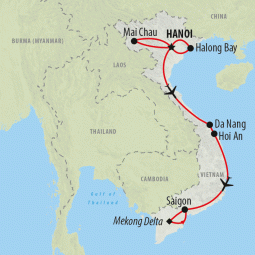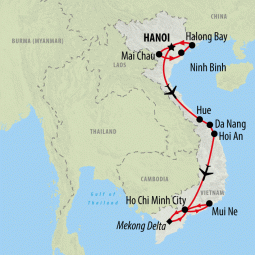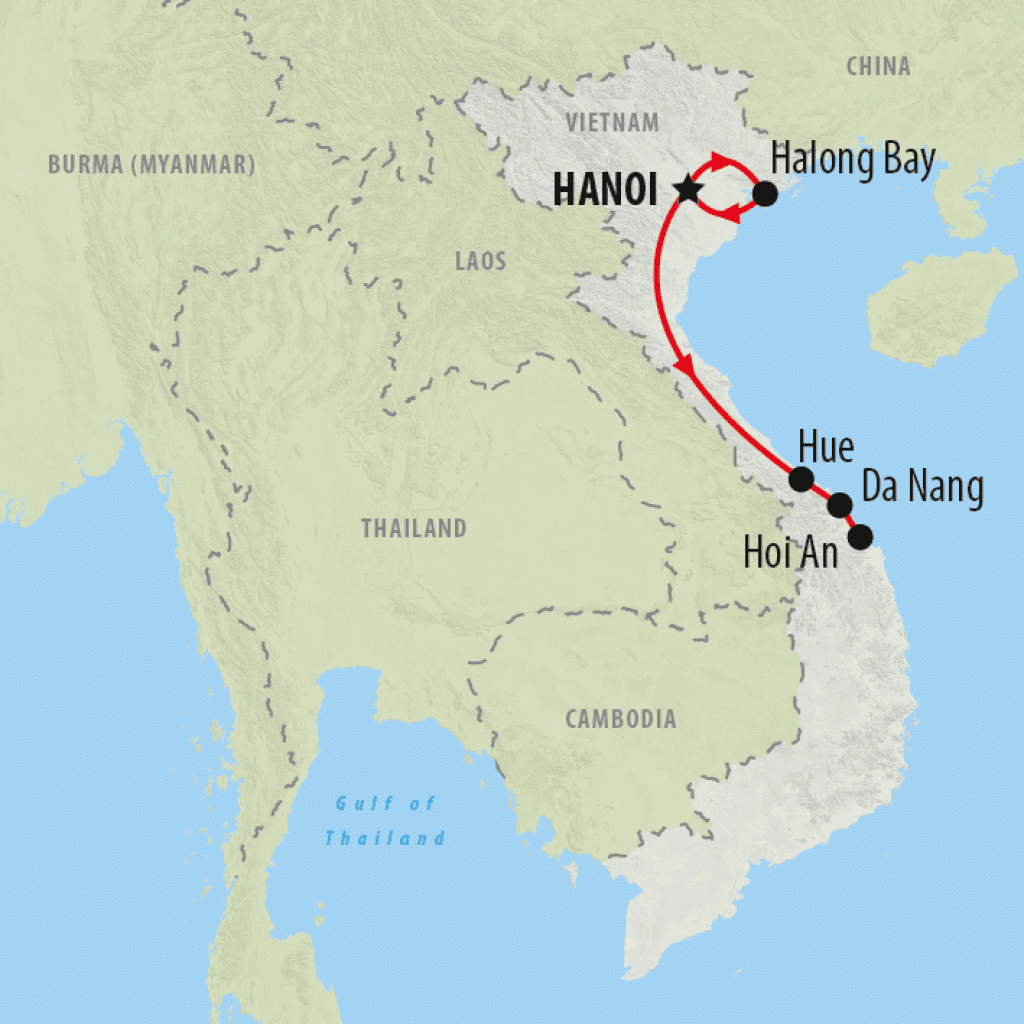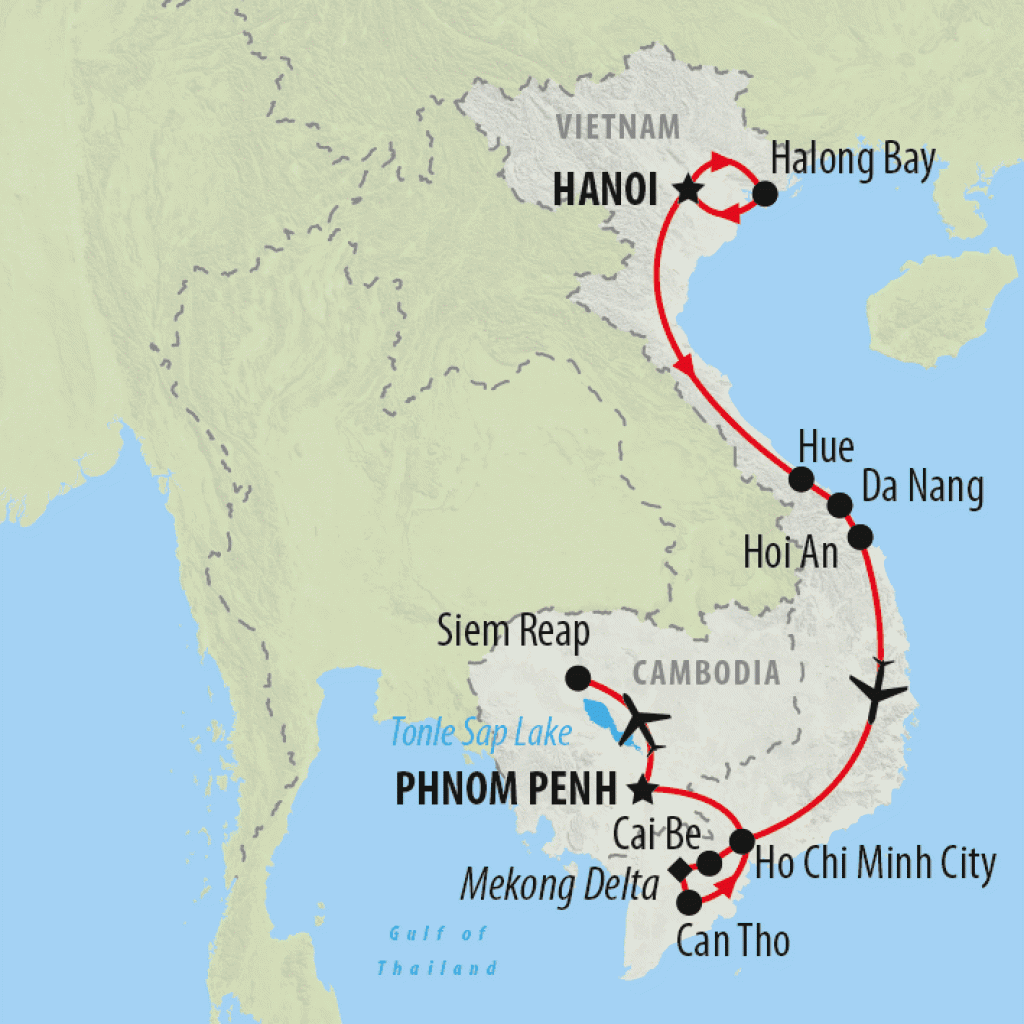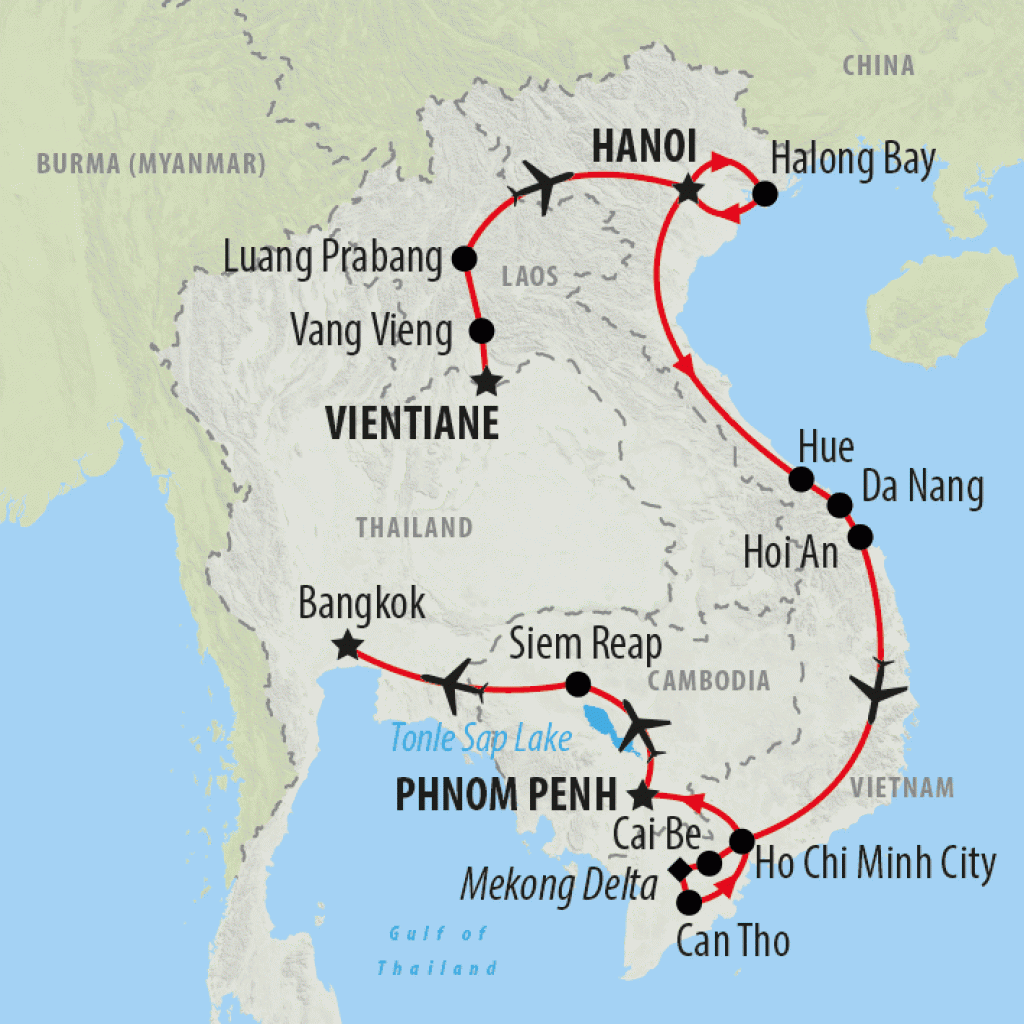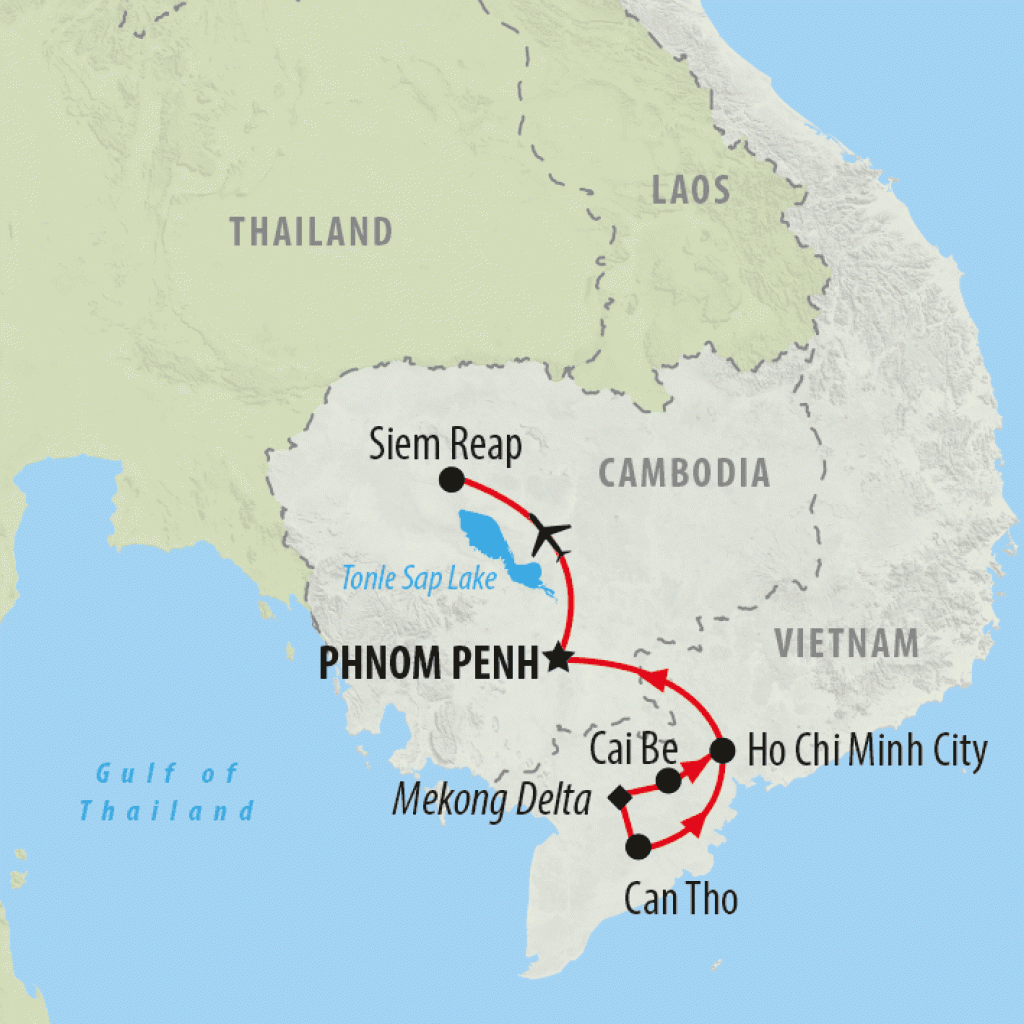North Vietnam and the Highlands
The northern region of Vietnam is a land of remarkable scenery with high rolling mountains, dramatically steep valleys and magnificent rice paddies creating a patchwork of contours. It's here you'll find endless opportunities to enjoy a host of trekking opportunities from easy walks along well-trodden paths to strenuous treks over the course of a couple of days. It's here you'll also find Vietnam's tallest mountain peak - Fansipan - at a height of 3,143 meters above sea level silently waiting to challenge those looking to scale its summit. What makes this part of Vietnam even more attractive to outdoor enthusiasts is the vibrant hill tribe culture and the ethnic minorities that call this region home.
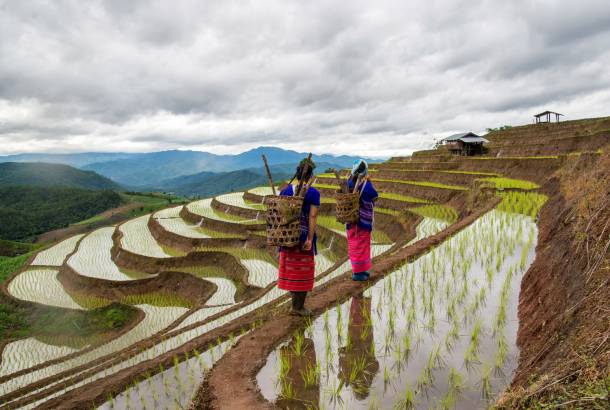
An Introduction to the Hill Tribes of Northern Vietnam
Over 50 distinct ethnic groups are recognized in Vietnam, each with their own unique language and culture though all share a traditional rural existence that has passed down the generations, cultivating the land for crops and cattle. Ethnic minorities make up between 10 to 15 percent of the population in Vietnam, which equates to around 12 million people, and these minorities are separated into eight major groups based on language, which in turn are separated into 54 subgroups based on dialect and clothing.
To help you know your Tay from your Thai, we've put together this quick guide to the main hill tribe groups you'll encounter while trekking in northern Vietnam.
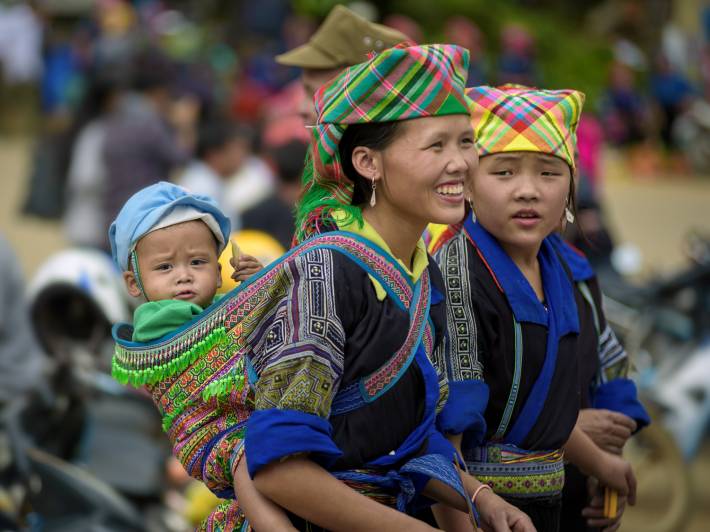
H'mong
The H'mong people are one of Vietnam's most populous ethnic groups with an estimated one million people. Originally from China, early descendants migrated to Vietnam in the 19th century and today the H'mong inhabit the mountainous terrain along the border, cultivating rice and raising animals. The H'mong people are divided into subgroups based on differences in clothing including the White, Red, Green, Black and Flower groups. Of these groups the Flower H'mong are known for their vibrant dress with rainbow-colored banding and sequins that decorate their clothing.
Tay
The Tay group are Vietnam's largest ethnic minority with a population of 1.7 million people, making up just less than 2% of the country's overall population. They are also one of Vietnam's oldest ethnic groups, believed to have inhabited the low elevations and valleys northeast of Hanoi since 500 AD. Over the centuries they have adopted Vietnamese religious beliefs in Buddhism and Taoism combined with their original spirit worship. Their culture and artistic traditions are particularly rich with their own written language and folklore, music and dance that has become famous throughout the country. The Tay people wear less colorful outfits than their fellow hill tribes with a preference for indigo-dyed cotton trousers and shirts with little embroidery detail.
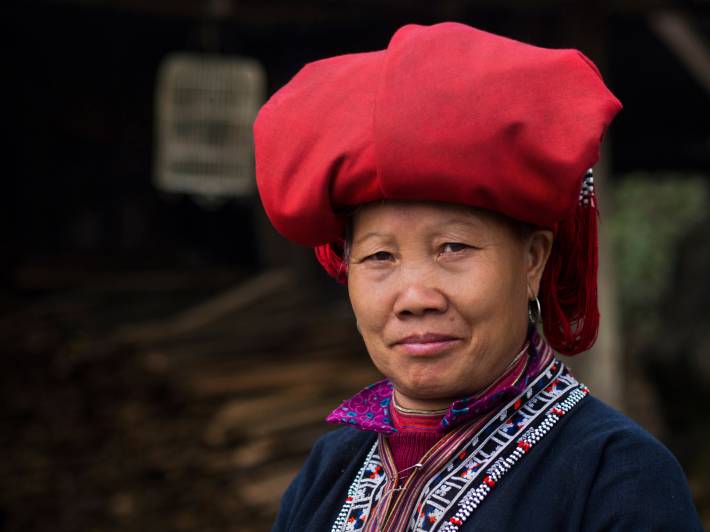
Dzao
With a population numbering close to half a million, the Dzao (or Zao/Dao) people are a frequent sight in Vietnam's northwestern provinces and quickly identified thanks to the large red turbans worn by the women to tie up their long hair. Women also tend to shave their eyebrows and hair above the forehead, considered beautiful among the tribe. Sharing a language and ancestral home with the Hmong group, the Dzao started migrating to Vietnam as early as the 13th century and have retained their traditions of ancestor worship and sacrificial rituals.
Giay
The Giay group belong to the larger Tay-Thai ethnic group, sharing a language and, like the Thai tribes, a preference for houses raised on stilts with an area reserved for an altar where ancestor worship is practiced. They are one of Vietnam's smaller ethnic groups with a population close to 50,000 spread across the districts closest to the Chinese border. The Giay people dress quite simply with cotton shirts and long skirts for the women and wide trousers for the men. The colors worn by women depend on their age with darker colors worn by older women and lighter colors by younger women.
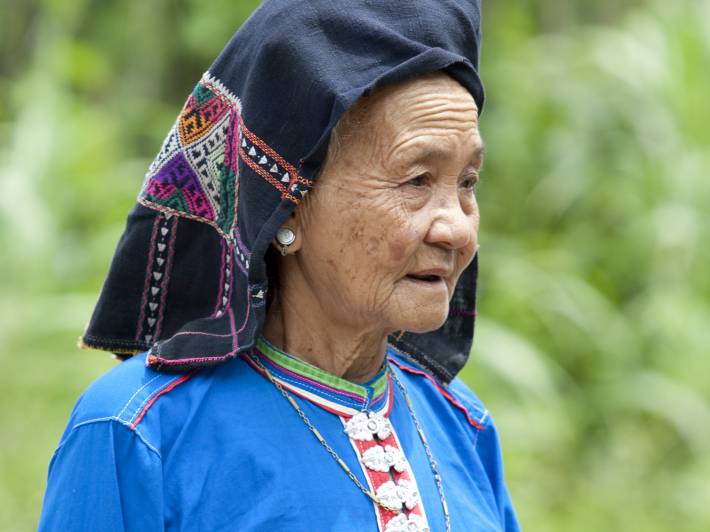
Thai
The Thai are the second biggest ethnic minority in Vietnam with a population of 1.5 million inhabiting the fertile riverbeds of the northwestern provinces. They originated in southern China and are categorized by color based on their dress with the White, Black and Red Thai subgroups. Known for their beautifully woven garments, the Black Thais typically wear block-colored shirts with a distinctive row of buttons in the shape of different insects while the White Thais opt for more contemporary dress with white headscarves. The Thai people are noted for their stilt houses built to protect the family abode from potential floods and roaming animals.
Where to go trekking in Vietnam
From the Tay villages in Vietnam's far northeastern corner to the colorful Hmong villages where women dress in elaborate embroidered regalia, Vietnam's hill tribe towns are a fascinating draw. It's possible to trek to many of these hamlets, meeting locals along the way with the option to sleep at local homestays on longer trekking trips. Here's our choice of Vietnam's top spots for hill tribe trekking, whether you're looking for tried and tested routes or off-the-beaten track escapes.
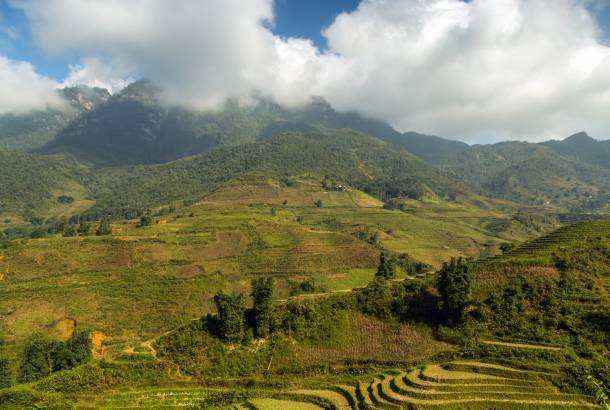
Sapa
The former French hill station of Sapa is Vietnam's prime hill tribe trekking destination and with good reason thanks to its epic scenery, excellent hiking opportunities and proximity to the Hoan Lien Mountains where you'll find Fansipan peak. Within easy walking distance of Sapa are a number of ethnic minority villages including Cat Cat, the Black H'mong settlements of Sa Seng and Hang Da, the Giay village of Ta Van and the Red Dzao village of Ta Phin, which also claims an attractive waterfall nearby. The routes to these villages vary between easy gradients and steep descents though with so many villages in the area it's easy to find a route that suits any level of fitness. There's also often the option to take an xe om (motorbike taxi) one way and hike the other for those short on time or inclination to trek the entire loop back to Sapa. Many visitors opt for day treks using Sapa as their base and returning to a comfortable hotel each night but for serious trekkers there are 2-, 3- and even 4-day treks available spending each night at a local homestay, which means you can get up the next morning and hit the road straight away.
The town of Sapa is also home to a popular market where local villagers congregate to buy and sell all manner of goods from fresh produce to traditional handicrafts. The market is at its busiest on a Saturday but it's a great place to visit on any day of the week to see the colorful array of northern Vietnam's ethnic groups in one place. Each village will generally have their own market day once a week so it's possible to coincide longer treks in the area with the local shopping calendar.
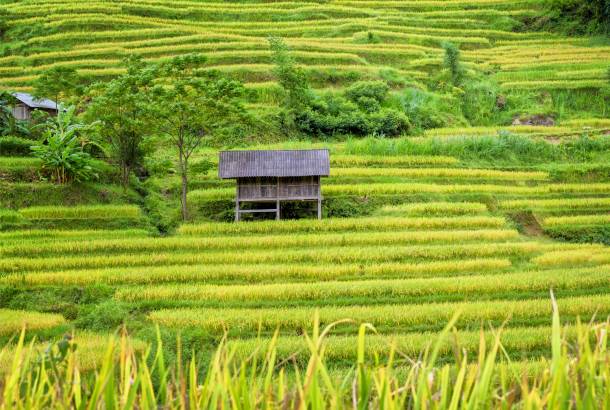
Mai Chau
Inhabited by the white and black Thai people, the small town of Mai Chau is nestled in an idyllic green valley surrounded by rustic local villages and peaceful countryside. The Thai ethnic groups are known for their stilt houses, designed to escape the worse of flooding caused by heavy rains, and here in Mai Chau it's possible to spend a night in a local Thai stilt house in the villages of Lac and Pom Coong. Waking up to the sound of birdsong and the snorts of water buffalo make for a memorable experience and visitors will be pleasantly surprised by the level of comfort at these homestays with electricity, hot water and mosquito nets provided. The local women are expert weavers so it's a great place to pick up souvenirs and textiles, and the mountainous surroundings are perfect for subterranean adventure with numerous caves and grottoes filled with dramatic formations.
The town's location 135km north of Vietnam's capital makes it a popular option with Hanoi's student population, especially on the weekends, so for Mai Chau at its quietest visit during the week and outside of holidays.
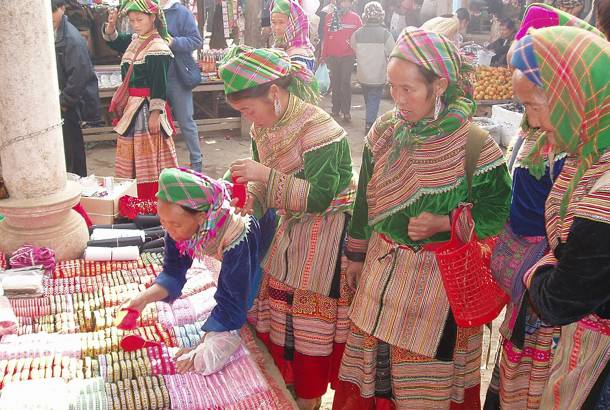
Bac Ha
The sleepy mountain town of Bac Ha is famous for its riotous Sunday market when ethnic groups come from miles away to flog their beautiful handicrafts of textiles and silver jewelery. The technicolor Flower H'mong women stand out from the crowd with their several layers of marvellous attire fringed with frills and finished off with embroidered cuffs, headscarves and ankle warmers. It's a photographer's dream with buyers inspecting the work animals on sale, young ethnic children asking mothers for treats from the food stalls and groups of men congregating in the drinking tents enjoying a shot or two of the potent local home brew known as ruou.
Trekking around Bac Ha is a rewarding experience with spectacular rural scenery similar to that of the more popular Sapa but without the number of visitors. Here you can hike relatively isolated trails among unspoiled countryside with locals making their way to and from their homes and farms. Bac Ha serves as a good base with a growing number of inexpensive accommodation options from simple guesthouses to more comfortable hotels. From Bac Ha it's possible to spend a day trekking to the Flower H'mong village of Ban Pho and on to the Nung settlement of Na Kheo. Longer treks are also available in the area with an 8km return walk to Trieu Cai village.
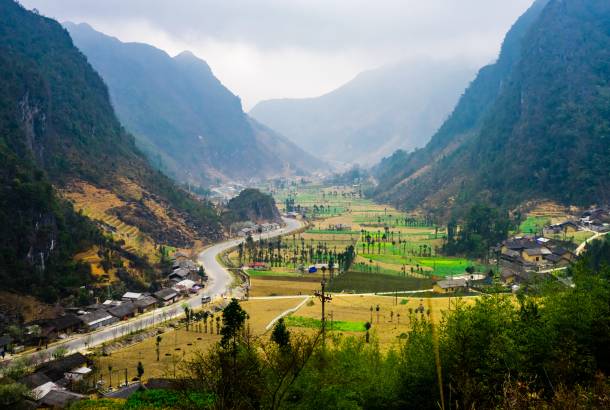
Ha Giang
The frontier province of Ha Giang in the far north of Vietnam is home to some of the country's most striking landscapes. The region is characterized by rolling karst peaks and verdant limestone pinnacles. It's a quieter and less well-known version of Halong Bay with the jade waters replaced with the vivid greens of the patchwork of rice paddies that carpet the expansive valleys. The provincial town of Ha Giang serves as the capital and is a good base for day treks in the area, with budget hotels and cheap restaurants serving basic needs. Longer treks to H'mong villages are available including two-day itineraries to Dong Van and Meo Vac near the Chinese border or the outstanding rice terraces of Hoang Su Phi.
The remoteness of the province is half of the appeal, with very few foreign visitors, quiet roads, untouched landscapes, and an absence of any commercialism, though this remoteness also means some forward planning is required. The only way to reach Ha Giang is by road with a five-hour scenic journey from Hanoi and at present permits need to be obtained if you wish to explore the region north of Ha Giang town.
More Hiking Destinations in Vietnam
There's plenty more opportunities for scenic hiking elsewhere in Vietnam whether you're looking for mountain hiking or rambling adventures in the countryside. Aside from the hill tribe villages and market towns, Vietnam's mountainous north and Central Highlands are home to a number of national parks and reserves that offer scope for outdoor adventure as well as verdant islands in Halong Bay ripe for exploration.
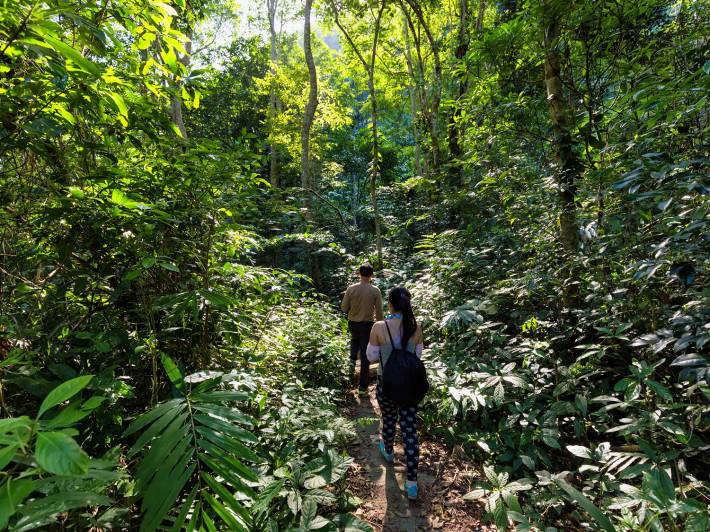
Cat Ba Island
Halong Bay's largest island is a jungle-clad karst peak that over the years has become a prime adventure sports destination with biking, hiking and rock climbing all on offer. Half of the island is encompassed by a national park with good hiking trails including a tough-going 18km summit route. Shorter and easier hiking trails are also available.
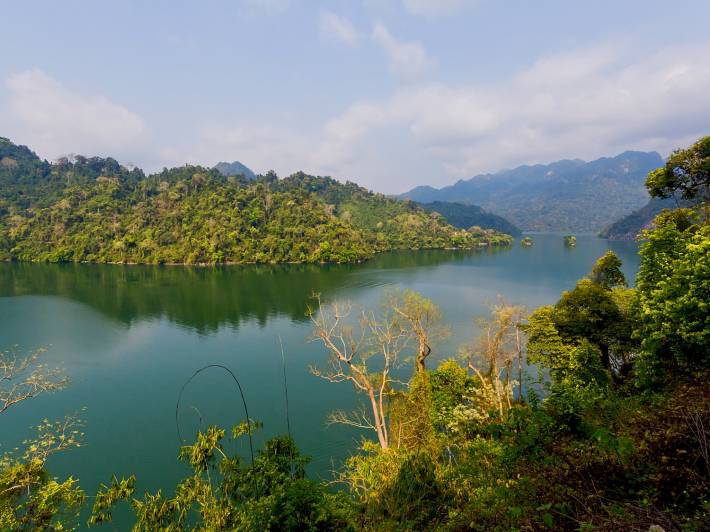
Ba Be National Park
With limestone peaks, plunging waterfalls and verdant forests home to a surprising range of wildlife, the Ba Be National Park is one of Vietnam's best and a perfect hiking destination. The centerpiece of the park is the Ba Be lakes, three linked lakes measuring a distance of 8km with still waters that beautifully reflect the surrounding vegetation. It's possible to explore the lake by dugout canoe.
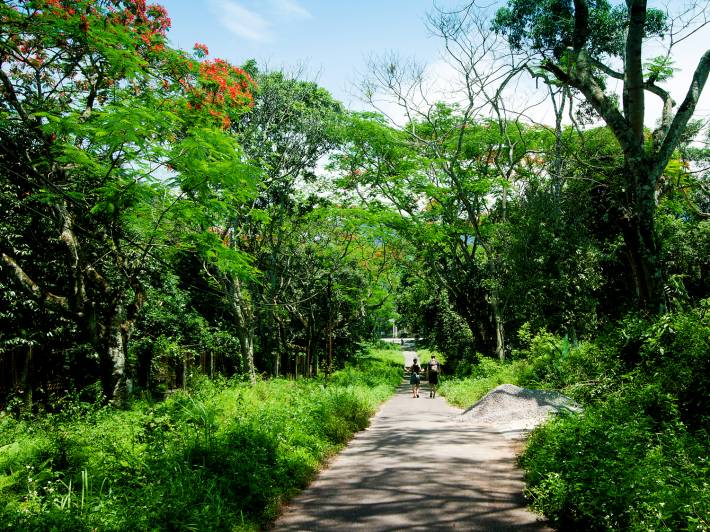
Cuc Phuong National Park
Vietnam's first national park protects some of the country's last remaining primary tropical forest and is an important site for biodiversity with over 300 species of bird and more than 2,000 plant species recorded here. The park's 222 sq km encompasses two limestone mountain ranges with short walks available to a large botanic garden and longer hikes to villages of the Muong minority people.
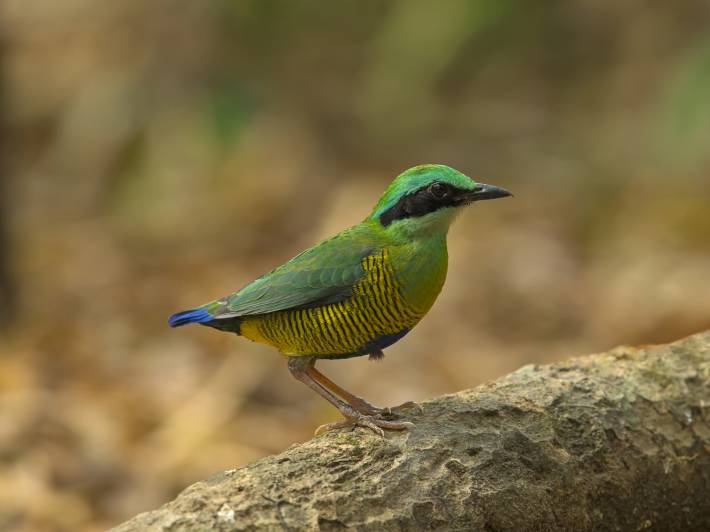
Cat Tien National Park
Nowhere in southern Vietnam beats the Cat Tien National Park for its amazing biodiversity and outdoor adventure. Designated a UNESCO biosphere reserve in 2011, the park is home to many ancient trees, numerous birds, mammals, reptiles and amphibians, as well as over 400 varieties of butterfly. The grasslands and forests can be explored via the well-established hiking trails and with a number of comfortable bungalows in the park, it's possible to overnight here and spend a few days exploring the area.
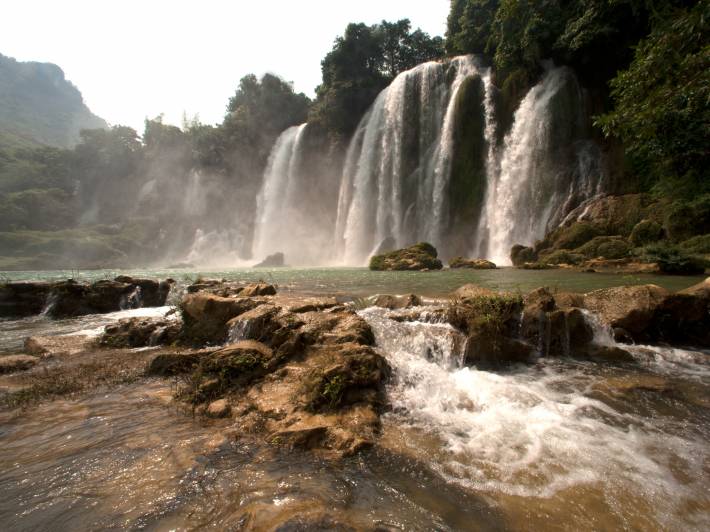
Cao Bang Province
Nestled in the far north of Vietnam along the border with China, the Cao Bang province is one of the country's most picturesque areas with lakes, caves, waterfalls and minority market towns. The high mountains and untouched jungle afford fabulous trekking opportunities with three-day and longer tours taking in some of the region's most impressive landscapes and charming rural villages.
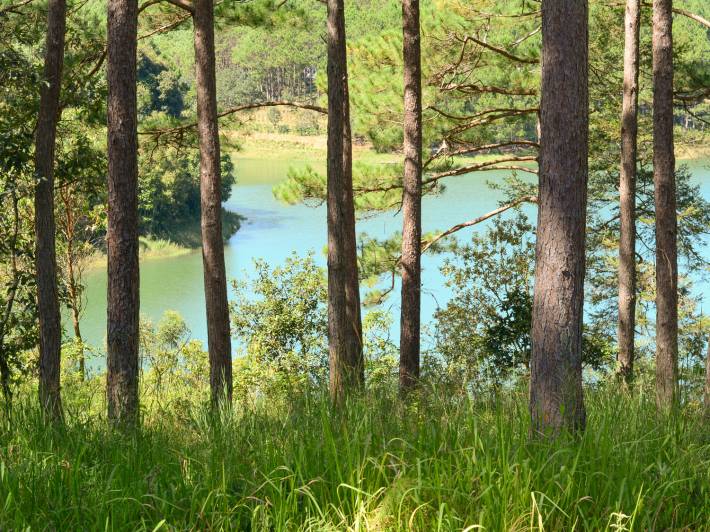
Dalat
Situated in the Central Highlands at a cool altitude, Vietnam's premier hill station of Dalat is the perfect base for forays into the surrounding terrain of leafy valleys, pretty lakes and small waterfalls. The nearby Lang Bian Mountain with five forested volcanic peaks offers great hikes to the summits with excellent views of the neighboring scenery.
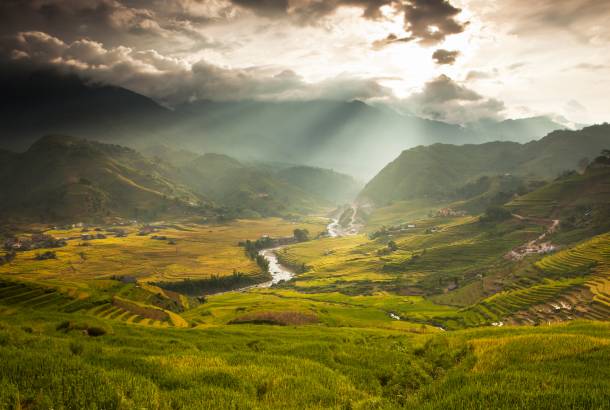
Best Time for Trekking in Vietnam
The dry season is between October and May and this is the best time for trekking in northern Vietnam. Within this season some months stand out as better options than others, chiefly March and April for warmer temperatures, spring blooms and little rain. Generally October and November experience relatively stable climatic conditions with cooler temperatures and clear blue skies, more often than not. December to February can be bitterly cold though the possibility of snow dusting the landscape has its draw and what with holidays this can be a surprisingly busy period, especially in Sapa.
Bear in mind that the weather at these altitudes is highly changeable and it may rain at any time so pack accordingly (more on that below). Fog is also common up in the mountains and so on occasion those perfect valley vistas may be somewhat obscured.
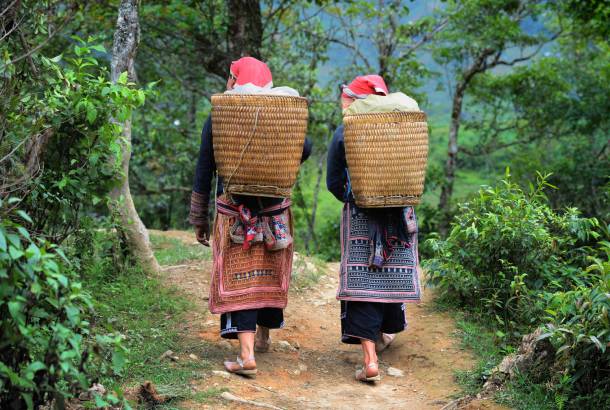
Recommended Packing List for Trekking in Vietnam
Having the right equipment and clothes can make all the difference between a comfortable trek and one you wish would be over as quickly as possible. Little specialized gear is needed when trekking in northern Vietnam and most visitors to the region will leave their main luggage at their chosen base town, using a smaller day bag to carry around the essential bits that they need while out trekking. So that you can get the most out of your trekking experience, here's our guide on what to pack.
- Comfortable and supportive walking boots that have been well worn in
- Waterproof jacket with a hood
- Light colored cotton clothes including trousers, a pair of shorts and t-shirts
- Thermal underwear if trekking in the colder months or if staying in provincial homestays where heating is not available
- Fresh clean socks - preferably with padded heels and toes for added comfort and protection against blisters - you'll want a fresh pair for each day of your trek
- Microfleece jumper to keep warm when the weather turns cold
- Silk or cotton sleep sheet for your personal comfort when spending a night in a local homestay on longer treks
- Torch or headlight
- Mosquito repellent and good quality high SPF sunscreen
- Hand and/or face wipes or hand sanitizer gel
- Smaller denomination notes in Vietnamese dong for souvenir shopping when visiting markets and meeting local hawkers
- Toilet paper for toilet stops while trekking
- Camera with charged batteries and plenty of memory for the hundreds of photos you'll be inspired to take
- Suitable day bag to carry it all in
Recommended Tours for Trekking in Vietnam
Here's our selection of Vietnam tours that include hill tribe trekking in the northern highlands or alternatively you can browse our full collection of Vietnam tours and consider adding our 5 day Sojourn to Sapa trekking package before the tour to give you more options. If you have a particular itinerary in mind, contact our tailor-made team who would be happy to put together your dream holiday and trekking adventure.
See Also
When planning your trip to Vietnam take a look at our other handy resources:
Best Time to Visit - climate and weather in Vietnam
Best Places to Visit - what to see in Vietnam
Tourist Visas - details on visa requirements for different nationalities
Top Travel Tips - useful information on money, health and junk boats in Vietnam
Hanoi or Ho Chi Minh City - compare Vietnam's northern and southern powerhouses
Traveler Reviews - see why our passengers enjoy our Vietnam tours
Popular Touring Destinations - combine the key drawcards of Vietnam in one tour
Hoi An Lantern Festival - all your frequently asked questions answered
Vietnam Video Lounge - stunning travel videos filmed in Vietnam
